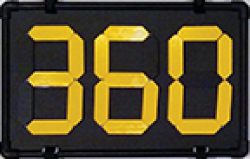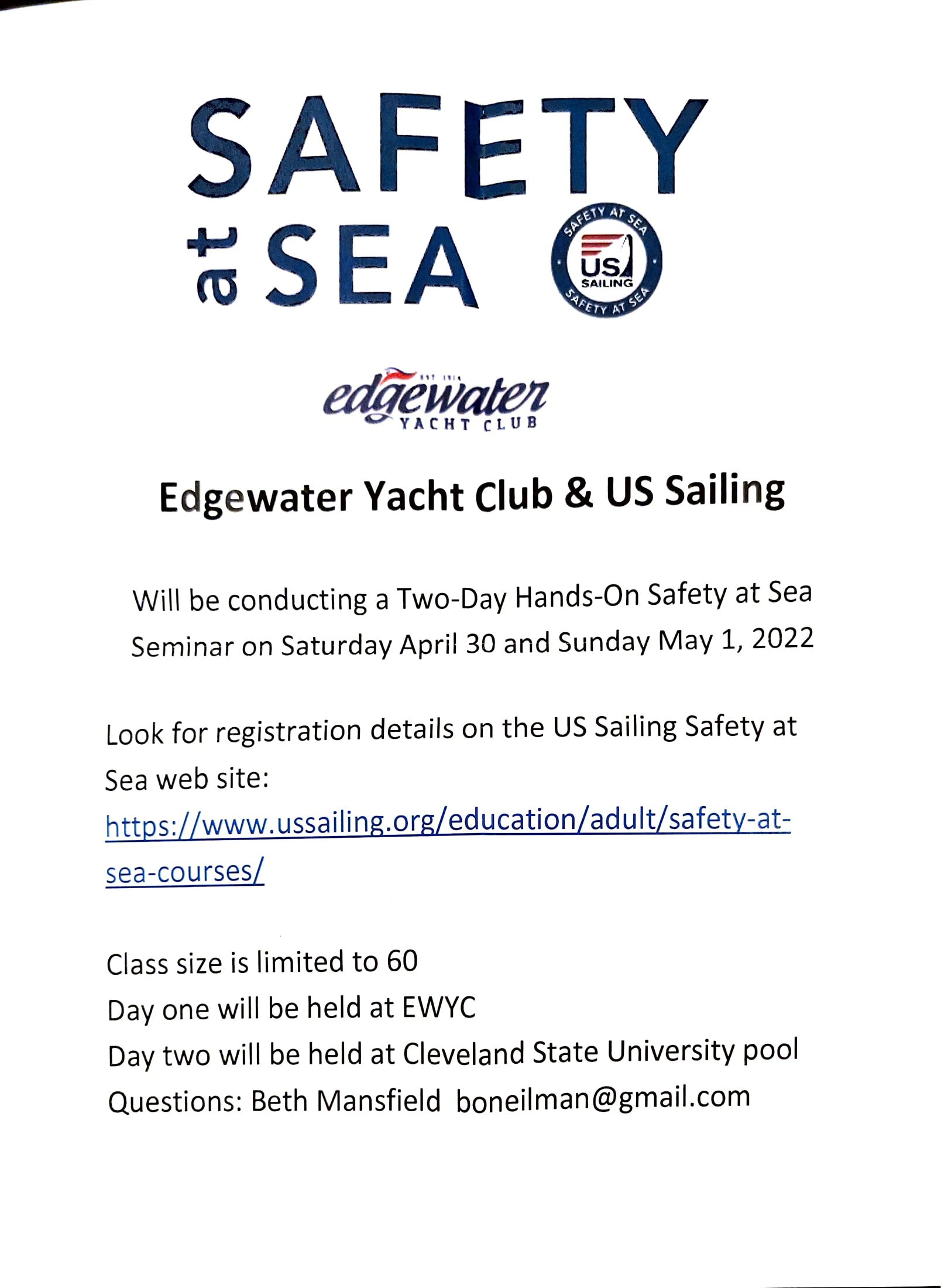Do have a sailing story, news, or helpful sailing-related information to share?
Please contact P/C Steve Harris to have it included. We’d love to hear from you.
RRS – Post #10 – “Grab Bag” 2
Often, we focus our rules discussions only on Part 2 of the rules – “When Boats Meet.” This winter, I plan to explore the rules of Part 3 – “Conduct of a Race.” They may appear to only matter to the Race Committee, but they have significant importance to the racing sailor too.
– Steve Harris, US Sailing National Race Officer
Rules 34 & 35 ...
This is another “grab bag” of other rules in Part 3. Each of their own importance, but not necessarily long enough for their own post. They have consequences for racing sailors but, generally, don’t require a long discussion.
Rule 34 - Mark Missing
- replace it in its correct position or substitute a new one of similar appearance, or
- substitute an object displaying flag M and make repetitive sound signals.
Placeholder
Rule 35 - Race Time Limit & Scores
If one boat starts, sails the course and finishes within the time limit for that race, if any, all boats that finish shall be scored according to their finishing places unless the race is abandoned. If no boat finishes within the race time limit, the race committee shall abandon the race.
RRS – Part III; Post #8 – Rule 33
Often, we focus our rules discussions only on Part 2 of the rules – “When Boats Meet.” This winter, I plan to explore the rules of Part 3 – “Conduct of a Race.” They may appear to only matter to the Race Committee, but they have significant importance to the racing sailor too.
– Steve Harris, US Sailing National Race Officer
Rule 33 - Changing the Next Leg of the Course
“While boats are racing, the race committee may change a leg of the course that begins at a rounding mark or at a gate by changing the position of the next mark (or the finishing line) and signalling all boats before they begin the leg. The next mark need not be in position at that time.
If the direction of the leg will be changed, the signal shall be the display of flag C with repetitive sounds and one or both of
the new compass bearing or
a green triangle for a change to starboard or a red rectangle for a change to port.
If the length of the leg will be changed, the signal shall be the display of flag C with repetitive sounds and a ‘–’ if the length will be decreased or a ‘+’ if it will be increased.
Subsequent legs may be changed without further signalling to maintain the course shape.”
Although a bit lengthy, this rule is actually pretty straightforward. To ensure that we’re all using the same language, recall the post on RRS 32 about Shortening the Course…
Shortening the course is the elimination of legs of the course. This is part of RRS 32.
What this rule (RRS 33) speaks to is Changing the course. This sometimes creates confusion, as we discussed in Post #7. But, if you remember “C is for Change,” you’ll be fine with this rule.
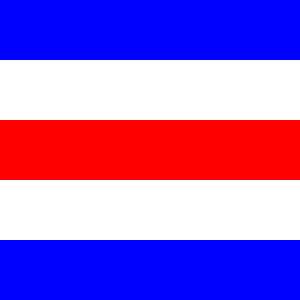
Keep in mind, the racing rules are written in such a way as to give the race committee tools that allow them to save a race. Lots of things happen on a race course that have the potential to make it less than ideal…
- Wind shifts make the course less than fair
- Changes in wind velocity make it desirable to change the length of the course.
- Changes in wind velocity make it unlikely that any boat will finish within the time limit.
- Impending safety concerns (foul weather, heavy seas, etc.) make it desirable to shorten the overall time the boats are going to be on the water
- etc.
Rule 33 makes it possible for the race committee to adjust to these changes and keep the racing fair, safe, and competitive.
Let’s look first at changing the direction to the next mark…
In the case of a wind shift, the course becomes less square and inherently less fair. Often, you’ll hear the argument “We’ve all got to sail in the same wind” as a reason not to move a mark and change it’s location. The problem is, not all boats in the fleet are truly in the same wind when the course isn’t square! Depending where you are on the course when the shift happens, some boats will be benefitted by a lift and others will be hampered by a header… and perhaps significantly so. Additionally, the tactically sailable area is also significantly reduced.
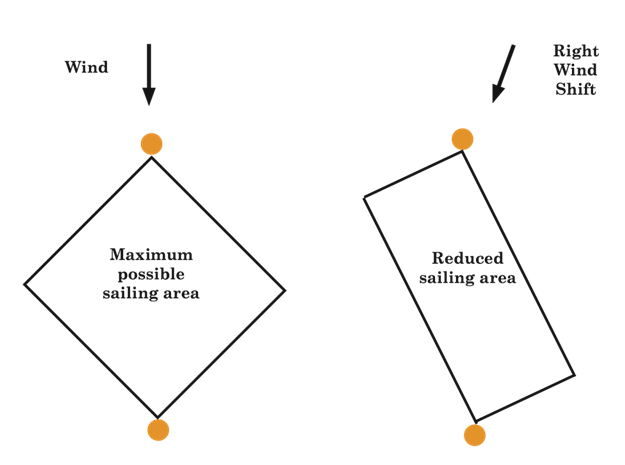
In order to maintain the best tacking angle upwind, the area in which boats can tactically sail in is significantly reduced.
Assuming an upwind tacking angle of 90°…
SHIFT
0°
5°
10°
20°
30°
45°
TIME ON
FAVORED TACK
50%
54%
59%
68%
79%
100%
EFFECTIVE
SAILING AREA
100%
98%
94%
77%
50%
0%
It gets even worse downwind…
Assuming a downwind gybing angle of 50°…
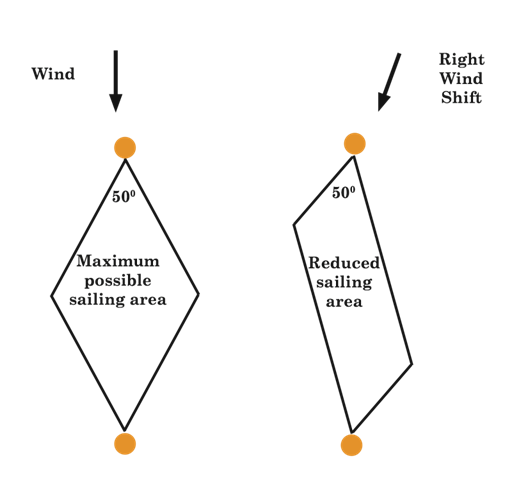
SHIFT
0°
5°
10°
15°
20°
25°
TIME ON
FAVORED TACK
50%
59%
69%
79%
89%
100%
EFFECTIVE
SAILING AREA
100%
96%
83%
62%
35%
0%
The effective sailing area reduces much quicker with less of a shift!
If the race committee doesn’t change the course, it’s hard to call it a fair, tactical, and competitive race. Changes are critical to making races competitive!
The difficulty for the race committee is knowing when to make a change. It’s easy to get drawn into trying too hard to make it “perfect,” and changing when a shift is just an oscillation. But its important to change when necessary. Now you know why sometimes race officers are so uptight & tense! LOL
So… how is a change signaled?
“…
If the direction of the leg will be changed, the signal shall be the display of flag C with repetitive sounds and one or both of
the new compass bearing or
a green triangle for a change to starboard or a red rectangle for a change to port.“
The important part to be able to recognize is the display of the flag, C, with repetitive sounds. Direction of the change is likely apparent, however the race committee is required to signal it.
Generally, the change will be signaled by a mark boat, near the mark previous to the one being changed. Unlike the shorten course signal (RRS 32), a change must be signaled before any boat sails the new leg of the course.
The race committee has two options:
- They can display the compass bearing to the new mark:
- They can signal a change to starboard (right as one looks towards the next mark) with a green triangle…
The race committee can also change the length of the next leg…
“…
So the race committee can change both the direction and the distance of the next leg of the course. Pay close attention to the signals being made. This affords them a great deal of flexibility in maintaining a competitive race course for the sailors.
Let’s look at one of our courses at BLYC…

This course, Course “E,” is a typical triangle-windward-leeward course –
S – 1 – 2 – 3 – 1 – 3 – F
Assume a significant windshift to the left makes it desirable to change the position of Mark 1 on the second windward leg.
The race committee will signal the change at mark 3 (before any boat begins the leg). They will hoist Code Flag “Charlie” with repetitive sounds and a red rectangle.
NOTE: The new mark need not be in the water yet. The signal tells you that a change is being made. By the rules, the mark doesn’t need to be there until boats are there to round it. Ideally, the race committee gets it into position well before any boat is approaching, but the rules give them a lot of leeway in making the change. Remember – the purpose is to “save” the race and keep it competitive.
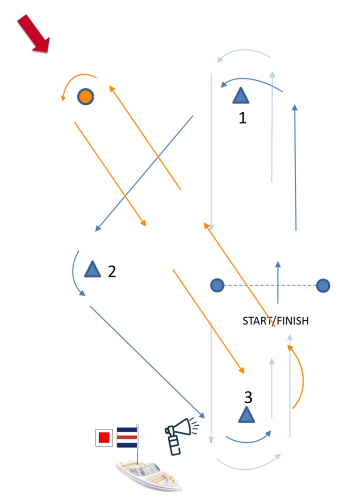
You would now sail to the “new” mark – ideally it is of a different color and/or shape (this would be described in the SIs), although that is not always the case.
Notice that, to maintain the same course angles, the race committee should also move Mark 3 and change the angle of the finish line. Sometimes with short course racing, this isn’t always practical if the fleet is spread out, but, ideally, that would be the proper thing to do.

Notice, however, that this subsequent “change” is not signaled…
“…
c. Subsequent legs may be changed without further signalling to maintain the course shape.”
Once the first change is signaled, subsequent changes do not have to be signaled. In other words, you should assume that subsequent legs are likely to be changed. The race committee is free to do so without tying up valuable resources signaling at each mark.
If a separate “change mark” is being used for the primary change, it is entirely possible that subsequent “changes” will not utilize these change marks. More than likely, the existing marks will be relocated to their adjusted positions if possible. “Change Marks” are not addressed specifically in the rules and there is not one standard practice used in this situation.
How much of a shift will initiate a change?
It depends…
Ok, not the best answer, but an accurate one. In some venues, the wind blows steady and at pretty much the same velocity and direction at the same time every day. Buckeye Lake is NOT one of those venues! In those places, particularly for “high level” events, a change of 10-15 degrees might be enough for the race committee to change the angle of the next leg. In places that are known for more shifty winds (like most of our region), that threshold is typically higher.
Knowing when to make a change is, very often, more of an art than it is a science. A good Race Officer knows the venue and has a good “feel” for local conditions (or, if visiting, has someone on board the RC boat who does.) One thing that seems to be a truism in race management is that any change will be greeted with both support and criticism. That’s the nature of things and perfectly understandable. Just as with most things rules-related though, I always remember George Fisher’s admonishment regarding the rules… “Don’t let one incident ruin your whole race.” The race committee may signal a change you think was unnecessary (maybe you were on the “lifted” side of the course and had gained an advantage.) Trust that they made the change for good reason, sail the course and keep sailing your race. Once signaled, right or wrong, that is the course you have to sail according to the rules.
Is it ever required for the race committee to change course?
Typically no…
Generall speaking, the rules of Part 3 are permissive rather than proscriptive. That is they allow the race committee options but, generally, they seldom require them to exercise those options. In the case of this rule, the decision is that of the race committee – “…may change a leg of the course…” The procedures to do so, however, are proscriptive – “… the signal shall be…”
Sometimes Sailing Instructions or Class Rules might give specific directions on changing course. Although, in my experience, I’ve found that, more often than not, they restrict the ability to change and proscribe abandonment instead. (rather than direct the RC when to make a change)
Next Week - Part 3 "Grab Bag"
... Rules 27, 31, 34, & 35
RRS – Part III; Post #7 – Rule 32 (con’t)
Often, we focus our rules discussions only on Part 2 of the rules – “When Boats Meet.” This winter, I plan to explore the rules of Part 3 – “Conduct of a Race.” They may appear to only matter to the Race Committee, but they have significant importance to the racing sailor too.
– Steve Harris, US Sailing National Race Officer
Rule 32 - Shortening or Abandoning After the Start
Last week, we discussed the “abandoning” part of this rule. This week, we’ll look at how the Race Committee can shorten the course under this rule. If you didn’t read last week’s post, you can click here to do so.
Let’s look at the text of the rule…
NOTE – Rule 32 only applies after the start. Rule 27.3 allows the race committee to abandon before the start for any reason.
32.1
“After the starting signal, the race committee may shorten the course (display flag S with two sounds) or abandon the race (display flag N, N over H, or N over A, with three sounds)
- because of foul weather,
- because of insufficient wind making it unlikely that any boat will finish within the race time limit,
- because a mark is missing or out of position, or
- for any other reason directly affecting the safety or fairness of the competition,
In addition, the race committee may shorten the course so that other scheduled races can be sailed, or abandon the race because of an error in the starting procedure. However, after one boat has started, sailed the course and finished within the race time limit, if any, the race committee shall not abandon the race without considering the consequences for all boats in the race or series.”
32.2
“If the race committee signals a shortened course (displays flag S with two sounds), the finishing line shall be,
- at a rounding mark, between the mark and a staff displaying flag S;
- a line the course requires boats to cross; or
- at a gate, between the gate marks.”
The reasons that the RC can shorten the course are, essentially the same as those for which they can abandon. There are some key differences, however. Additionally, Rule 32.2 provides specific guidance on how the course is shortened.
I won’t delve into the enumerated reasons for shortening under 32.1 as those were discussed in detail last week. However, Rule 32.1 also provides the following:
“In addition, the race committee may shorten the course so that other scheduled races can be sailed…”
The reasons for this additional directive may not seem readily apparent. But, simply put, there are often reasons to get more races in:
- Most often, becuase the SIs require a minimum number of races – greater than 1 – to count as a series.
- Sometimes, in a very competitive event, when scores are “tight,” it may be advisable to have more races rather than less, to give all competitors the greatest chance of finishing well over all. (i.e., keep the competition on the water, not in the hands of the race or protest committees)
- Generally, its felt that “saving the race” is a better option that abandoning. It’s no fun spending a lot of time fighting for a good finish to have the race committee “throw the race away.”
That said, race officers are advised in their training to carefully consider all factors when making the decision to shorten. Generally, course selection involves a number of good, well though out factors and changing that configuration “on the fly” by eliminating one or more legs may be counter to those reasons. But, the rule does provide race committees with that flexibility nonetheless.
What does it mean to “Shorten the Course?”
This is actually a point of confusion for many competitors and race committees alike. Intuitively, “shortening” implies keeping the course the same – same configuration, same number of legs & rounding marks, etc. – but making the distance less. That is not the case here.
Shortening the course is the elimination of legs of the course. What is described above is covered in RRS 33 – Changing the Next Leg of the Course (emphasis added).
Let’s look again at one of our “typical” courses at BLYC…

Under normal circumstances, sailing this course would entail the following (in order):
- Starting
- Rounding Mark 1
- Rounding Mark 2
- Rounding Mark 1 again
- Finishing
But… what if the wind starts dying off (and quickly) as most boats are rounding Mark 2 to start their 2nd windward leg. Looking at the reasons under which the RC is permitted to shorten…
- Is it likely that the first boat will finish within the time limit?
- If it is, is it still a fair race?
- Is this race valuable to series (i.e., “so that other scheduled races can be sailed”)
It may, very well, be desirable to try and “save” this race by shortening the course at the next mark (Mark 1, 2nd time) by eliminating that last leg to the finish.
As a side note… one thing that has become increasingly common in recent years, is race committees utilizing this rule to “finish closer to home” at the end of a race. That is, say in our Course C example above, the windward mark (Mark 1) is closer to where the boats are docked or hauled out. Eliminating the final leg finishes them closer to home than having them sail the final leg would. Certainly, it would be better if this was anticipated by the race committee and they chose a different course prior to the race instead, but that is not always feasible. In doing this, however, what part of Rule 32.1 allows this? I would contend that it could be a reason “… directly affecting the safety or fairness…” For example,
- Dying breeze – s a result of dying breeze, boats will need to be towed in. Towing a boat, even in light breeze and seas, is inherently more dangerous than the boat being sailed (or motored) in under the control of its crew
- Impending severe weather – while perhaps there is time to finish the boats by eliminating a leg, it is questionable whether or not there is time to finish and get the boats back to shore in time.
- Lateness of hour – it may be desirable to shorten the race in order to allow all boats to finish before nightfall. Depending on the boats competing, they may or may not have lights and other necessary safety equipment for night sailing.
How does the race committee shorten the course?
“… the race committee may shorten the course (display flag S with two sounds) …”

One interesting part of the rule is that there is no requirement as to when the flag and sound signal must be made. It only needs to be made in enough time that the first boat approaching the new finish mark (in our example above, the “old” Mark 1), sees and hears the signal to finish.
This is another frequent point of confusion and misunderstanding for many racing sailors. As we will see later with RRS 33 (Changing the Net Leg of the Course), those signals are made prior to boats sailing the leg. That is not the case with Rule 32 – and, in fact, it is for a very good reason.
If the shortening signal (eliminating a leg) was required to be signaled earlier, it may be too soon or not soon enough – think of the reasons to shorten… foul weather, insufficient wind, safety & fairness, etc. These are not things that can always be anticipated. Doing so might result in the signal being made unnecessarily (conditions improve) or, worse yet, leaving the race committee with only one option – abandonment – in the case of severe weather & safety.
Often, when considering shortening, the race committee will get everything ready, just in case, and the PRO will make the call at the last minute and direct the mark boat to hoist the flag with two sounds as the first boat is nearing the mark. How near? Close enough to see and hear the signals, yet not too close for it to be effective. Like many things with course management, it depends.
32.2
“If the race committee signals a shortened course (displays flag S with two sounds), the finishing line shall be,
- at a rounding mark, between the mark and a staff displaying flag S;
- a line the course requires boats to cross; or
- at a gate, between the gate marks.”
Rule 32.2 gives us the guidance on how, specifically this it to be executed. Let’s look at these one by one…
“1. at a rounding mark, between the mark and a staff displaying flag S;
This would be what we described in our Course C example above, the mark boat (or other boat signaling and taking the finishes) would set up such that competitors would finish between Flag S on their boat and the nearby mark.

- perpendicular to the course direction from the last mark
- anchored in position
- such that a boat rounding the mark as it “normally” would, it necessarily crosses the finish line without any need to sail the course differently than planned or intended
- As this mark was to originally be left to port, they would still be leaving it to port while finishing properly
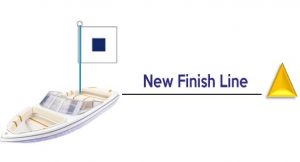
In the above situation, how would I finish properly?
You would finish according to Rule 32.2(1) – “…between the mark and a staff displaying flag S”
While, originally, you would have left Mark 1 to port – it is no longer Mark 1. It is now a finish mark.
Recall the definition of Finish…
“A boat finishes when, after starting, any part of her hull crosses the finishing line from the course side.”
It may be tempting, or even seem necessary, to leave the mark to port (as you originally would have) and round it in order to cross the new finish line. Doing so, however, would be improper. You would be scored as DNF as you didn’t cross the line from the course side.
Before we look at 32.2(2), lets look ahead at what would happen at a gate…
“3. at a gate, between the gate marks.”
Although for our typical Sunday races we seldom use gates, most of us are familiar with them. Most commonly used for downwind marks, a gate (instead of being a single mark) is composed o two marks, which you pass between, rounding either one.
In the race committee signals a shortened course at the gate, rule 32.2 is easy to comply with – sail betwen them as you normally would.

As shown above, this would be the ideal way the mark boat would set up the new line. It would be…
- perpendicular to the course direction from the last mark
- anchored in position such that they can see both marks in order to judge the line properly
- close enough to one of the marks that there is no confusion as to how to cross (i.e. there is no temptation to cross between the boat and the mark nearest to it)
Again, however, there is no requirement in the rule to meet the above conditions.
2. “a line the course requires the boats to cross”
Although the set-up and execution of 32.2(2) is easy enough to understand (it is, essentially, identical to 32.2(3)), this is often a very confusing part of the rule.
Why would there be a line that boats are required to cross that isn’t already a gate? In most sailboat racing, such a thing simply doesn’t exist.
I’m not sure that the situation I’m about to describe is what the writers were thinking when this was added, but we have a situation here at BLYC where we have taken advantage of this part of the rule – our Holiday Long Distance Races.
As you area aware our start/finish line for these races is usually in front of the race committee shack on the island and is comprised of two marks (rather than a mark and a flag on a boat). In recent years, we’ve written the SIs for these races such that boats are required to pass through this line on all legs of the course. Many think that this is so we can make the racing more interesting for the holiday spectators at the Club. While that is an advantage for sure, it actually isn’t the primary reason that we did it. Statistically speaking it doesn’t seem possible, but we almost always have light winds for the Holiday races. By making boats cross the start/finish line on every leg, the race committee has the option to shorten the course at that line. While those races are intended to be distance races. That said, there comes a point that sailing for seemingly hours on end in light air is simply neither fun nor practical.
There’s a lot that we’ve unpacked from Rule 32 these past two weeks, but hopefully it’s a little more clear now as to how it works and some of its unique nuances.
Next Week - Rule 33; Changing the Next Leg of the Course
Join Us at the 2022 I-LYA Sail Regatta
 Loading...
Loading...
Click on the ![]() icon above to expand the file
icon above to expand the file

